Therapy Dogs: The Science of Human-Animal Interaction
By Joan Tupponce | Photos by Jessica Hale
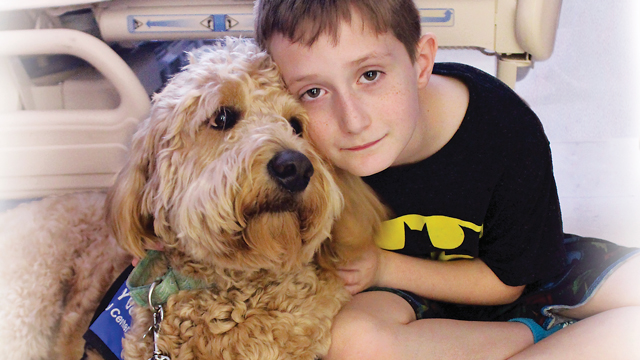
Goldendoodle Elsa is a rock star at VCU Medical Center, even though there’s no red carpet underneath her paws. The calm-natured, 55-pound sandy blonde fluffball strolls alongside her handler, Margaret Popik, down the halls of the pediatric inpatient unit at Children’s Hospital of Richmond at VCU. Along the way, doctors and nurses, as well as kids and parents, make their way over to Elsa to get their doggie fix for the day. Elsa is happy to oblige, posing for photos and sitting for a pat on the head or a hug.
Elsa and Popik are volunteers in VCU Health’s Dogs On Call Therapy Dog Program, part of the Center for Human-Animal Interaction. The program helps enhance the well-being of patients, staff, and students through canine-assisted interventions.
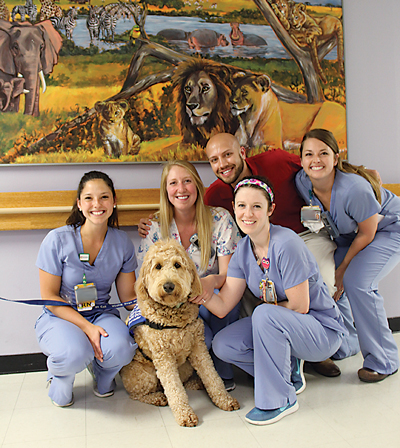
After going over a list of patients who may want visits, Elsa and Popik head over to see 8-year-old Savannah who is busy coloring a picture of Elsa from Frozen while she waits for her Dogs On Call visitor. She doesn’t know she’ll actually be meeting a furry version of Elsa this morning. When she sees Elsa, she slips out of the bed and moves closer to the visitor. “You’re very gentle with her,” Popik says of Savannah’s manner with Elsa. “She wants to be your friend and snuggle with you.”
Savannah’s mom, Betty, explains her daughter has a little dog at home and “loves dogs. She’s happier with a dog here.”
Elsa sprawls on the floor beside Savannah who seems more relaxed as she rubs Elsa’s head. “Elsa just loves you,” Popik says. “She is going to remember you forever.”
Popik could see the spark in Savannah’s eye when Elsa came to the door. “To see [patients] visibly relax and smile is when the magic happens. Sometimes you see tears in the eyes of the parents. These are subtle cues that we are making a difference. If that happens, it really does impact the child, and that is the whole reason I do it,” she says.
Popik first heard about DOC in 2014 when her son’s best friend was battling childhood cancer. “His journey profoundly impacted our whole family, and watching our close friends navigate this awful journey left me feeling helpless and empty,” she says. “A bright spot was hearing our friends talk about the joy that the DOC therapy dogs brought to their son. It is with a happy heart that I can report he is cancer-free now.”
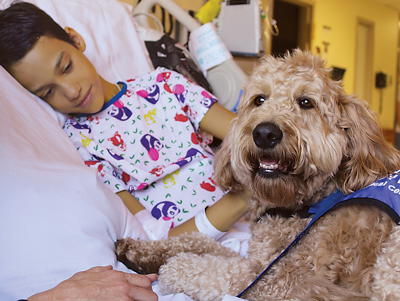
“Being able to provide a gift to these families going through this is magical for me,” she says. “I feel like we support the healthcare team by making the patient’s experience in the hospital that much better.”
The Only Center of Its Kind Launched in a School of Medicine
Established in the VCU School of Medicine in June 2001 and housed in the Department of Psychiatry, the Center for Human-Animal Interaction is involved in research, clinical, and educational activities related to the human-animal relationship. Through animal-assisted intervention like DOC, they hope to improve the health and well-being of patients and members of the community and to understand the benefits this type of intervention brings.
Numerous studies have shown the health benefits of working with animals. “Because of the research we had completed in the field in the nineties, they established the center here in Richmond,” says Sandra Barker, PhD, professor of psychiatry and director of the Center for Human-Animal Interaction. “We had been doing pet loss counseling and already had some therapy dogs in the health system when the center opened.”
There were a handful of therapy dogs coming into the hospital, including Dr. Barker’s Lhasa Apso named H.I., who would come with her to inpatient psychiatry where she could observe patient reactions to her dog and other therapy dogs. “Seeing a patient respond for the first time when they haven’t responded to anything else… it’s hard to explain that,” she says, adding that H.I. crossed the rainbow bridge years ago. “He was as popular with the staff as the patients.”
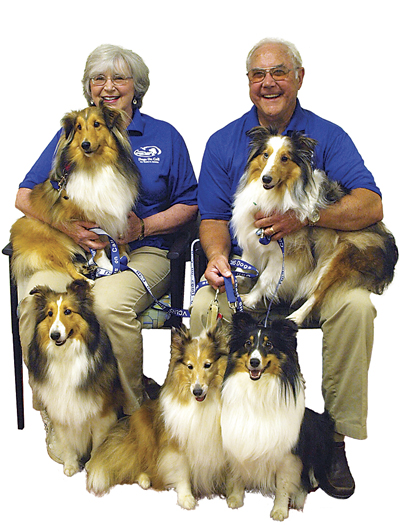
Medical students can enroll in an elective during their senior year to learn about the center. They can also participate in collecting survey data from patients.
Evan Schwartz, a fourth-year medical student in internal medicine, completed a month-long elective with DOC. “This is the non-traditional side of medicine where you can bring a smile to a patient,” he says. “You get to see a much different aspect of it.”
He spent last year studying the clinical side of medicine.
“Here, we tell them we want to bring happiness and sunshine,” he says. “We want to give you a break from what’s happening.”
About 99 percent of the patients are receptive when the dog comes in to visit, he adds. “Their eyes light up. They are more open.”
What the Studies Show
Dr. Barker has co-authored several studies with other healthcare professionals that recognize the value of therapy dog interventions in reducing stress. “We have been collecting patient satisfaction data, and it’s been amazing. We have had over 350 patients respond,” she says.
Ninety percent of patients surveyed say interacting with the dogs improves their mood. Eighty-five percent say it makes them more relaxed. “About one-third said it reduced pain and discomfort,” Dr. Barker says. “Over half said interacting with the dogs makes them less lonely.”
Therapy dogs aren’t just helpful in the hospital. Dr. Barker co-authored a 2016 randomized study regarding the effect of visiting therapy dogs on college students’ stress before final exams. The visits were extremely popular with students facing academic stress.
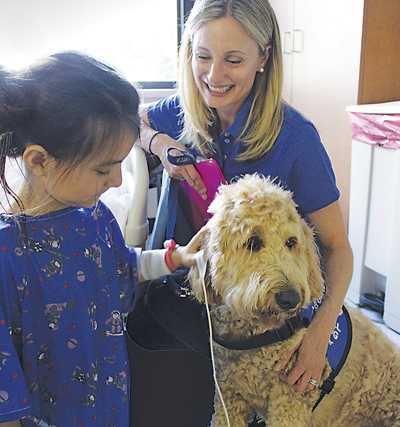
Two other studies she co-authored followed dogs in a workplace setting and in interactions with healthcare professionals. The first study compared employees who bring their dogs to work, employees who don’t bring their dogs to work, and employees without pets. The overall findings: Workers who had their dogs at work had lower stress than dog owners with dogs at home or employees without pets.
Findings in the study with healthcare professionals showed a significant reduction in their stress levels in as little as five minutes of interaction with a therapy dog. “They tell us all the time they love the dogs,” Dr. Barker says. “On stressful days, they call for a dog visit.”
The evidence-based DOC program has proven to be an effective intervention for anxiety, fear, and stress in patients and staff. “We know the dogs make a difference in our patients’ lives, our staff’s lives, and students’ lives,” she says.
The Dogs On Call Team
The DOC program has had all different types of dogs, everything from American Kennel Club champions to mixed breeds. “First, the dogs have to be registered with either Pet Partners or the Alliance of Therapy Dogs,” says Dr. Barker.
Popik and Elsa started basic obedience classes when Elsa was twelve weeks old and continued for about a year. Most of that work focused on “reinforcing good manners, making sure consistent boundaries were established, strengthening impulse control, and making sure she felt safe and secure with me as her handler,” Popik says.
Dogs accepted into Dogs On Call should already have stable temperaments and be reliable. “They have to always be under the owner’s control,” Dr. Barker says. Dogs must be able to sit and “stand on command. If they hear a loud noise, they might be startled, but they don’t react aggressively.”
The dogs are trained and socialized if they pass the initial test, and Dr. Barker says they monitor the teams and observe them on an annual basis to make sure everything is up to snuff.
Janie and Al Robertson have seven therapy dogs of their own and are testers with the Alliance of Therapy Dogs. They also teach therapy prep classes at Richmond Dog Obedience Club. “We are very passionate about therapy dogs,” Janie says.
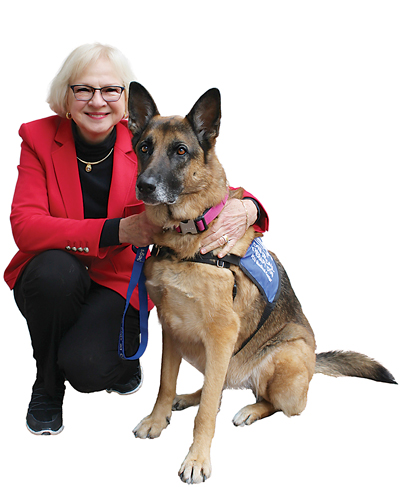
for college students at VCU and the University of Richmond during exam time.”
Additionally, they visit certain businesses so the dogs can spend time with employees who can pet them and “love on them,” she says.
Not every dog is suitable to be a therapy dog and not “every handler is going to pass the test,” Janie says. “For insurance and liability purposes, we have to make sure the dog has the right temperament and can handle situations without panicking.”
The Robertson’s dogs are all shelties, but they have different personalities and it’s important to recognize the situations that suit them the best. “We take different dogs on different visits,” Janie says. “One dog does a lot of tricks so that dog does kid visits. A couple of them are very calm and will curl up with the patient.”
Kim Wright, a volunteer handler with Dogs On Call, has two therapy dogs – Clark and Callie – who are both goldendoodles, and very different souls as well. Clark is more stoic than Callie. “Callie is my smiley girl,” Wright says.
Even though they can be in stressful environments, there is no evidence that being a therapy dog is hard on the dog physically or emotionally. “We train our dog handlers to be very aware of stress reactions in dogs,” Dr. Barker says. “We try to be very proactive to make sure this is an enjoyable experience for the dogs.”
The handlers are their dogs’ best advocates. “You are a team,” Wright says. “You are constantly watching your dog, making sure your dog is okay. You have to look for signs of stress, such as panting a little more or seeing that the tail is not quite as relaxed as before.”
The love the dogs bring to patients at VCU Medical Center is unconditional, she adds. “Most of the time, patients will say, ‘I have had a terrible day and this is the best way to end the day.’ There are no smiles when I go in a room and that changes after we come out. Everybody needs a little dog therapy. My dogs are therapy for me.”
Seeing the Proof
The benefits of a DOC visit are obvious for VCU Health Child Life Specialist Siri Garrett. “We see a lot of reduced stress,” she says. “We have seen kids smile for the first time since being in the hospital. They are willing to get out of bed and to move their arms and are much more willing to work with physical and occupational therapy.”
The dogs have even participated in a few tea parties, she adds. “We’ll have the dog drink some water and the child will say, ‘I will drink mine, too.’”
Occasionally, a therapy dog will walk with a child who is on the way to surgery. The patient is always hooked up to a portable monitor that checks his or her respiration and heart rate. “When they are anxious, we see their heart rate increase,” Garrett says. But when one of the dogs comes in, and the patient pets them, “you can see their heart rate decrease. They are not as anxious,” she says. “It helps us to recognize this child can be distracted. They don’t have to get anti-anxiety drugs because they are reacting positively to the dog.”
Patients who come in for treatment after a dog bite also benefit from therapy dog visits. “The DOC teams are incredible. They will have the dog lie down so it’s seen as less threatening,” Garrett says. “We have had a number of families who commented they didn’t think their child would be able to play with a dog again, and after therapy dog visits, they are playing with the dog. That is remarkable to see.”
Garrett will never forget a little girl who has since passed away. When she was at her sickest, a therapy dog would lie in bed with her and snuggle. “It was a time when she wasn’t scared or writhing in pain,” she says. “These are the times she had comfort. We are all so grateful for that.”
